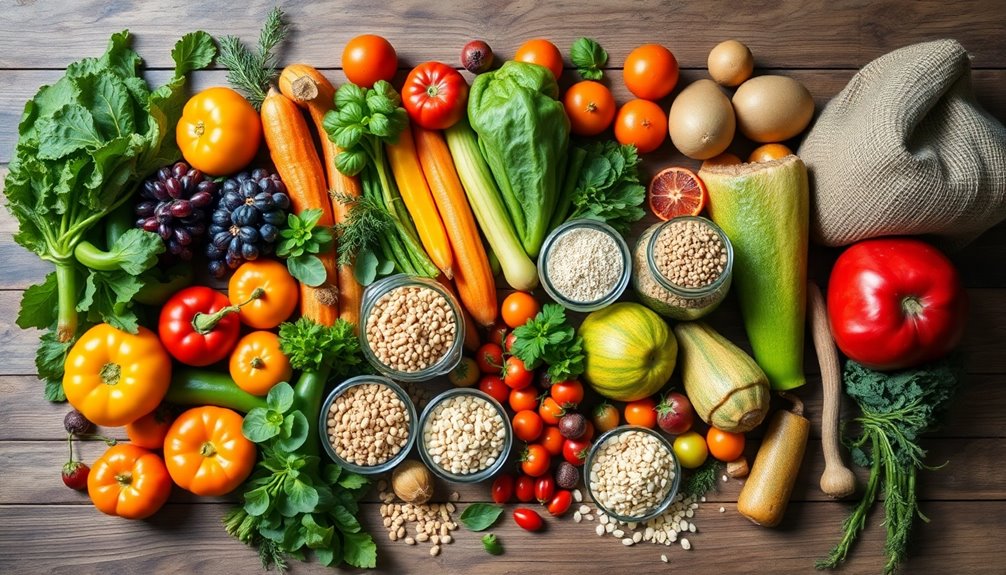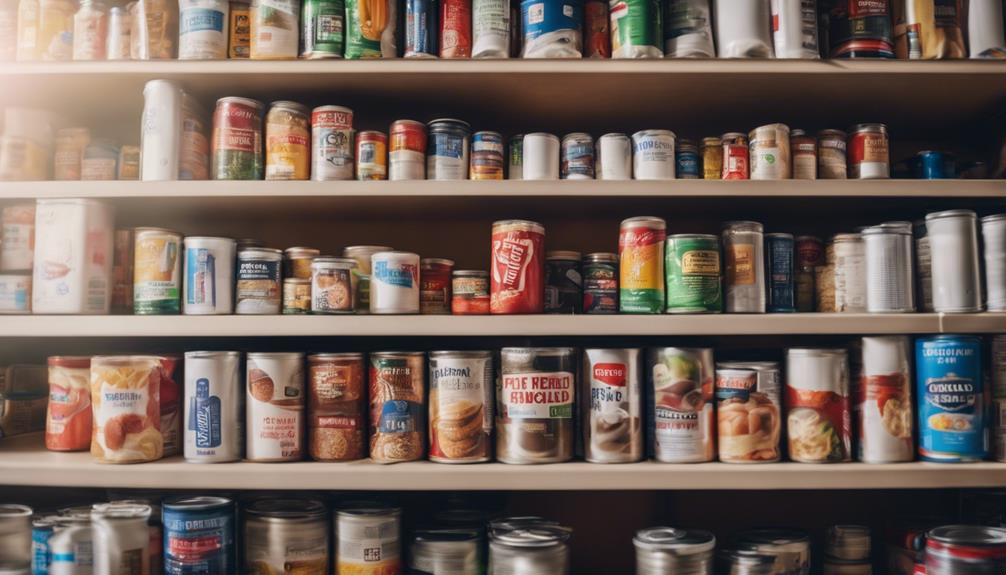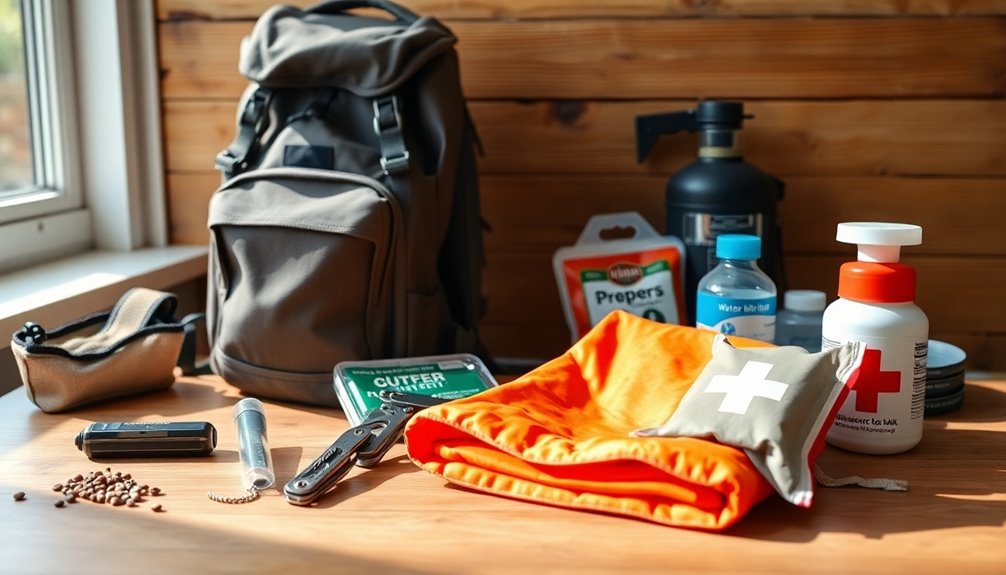To guarantee a year of ultimate food security, start by creating a thorough food supply list. Include non-perishable items like grains, canned meats, and vegetables, focusing on nutrient-dense choices for balanced nutrition. Don't forget to add water—aim for two quarts per person daily. Store your supplies in airtight containers in cool, dry places and regularly check expiration dates. Rotate stock to consume older items first. Organize everything clearly to make management easier. You'll discover effective meal planning and food safety strategies as you build your list, guiding you toward the best options for long-term preparedness.
Key Takeaways
- Include a variety of nutrient-dense non-perishable foods to maintain health and energy throughout the year.
- Plan for at least two quarts of water per person daily to ensure adequate hydration.
- Rotate your food supply regularly, consuming older items first to minimize waste and ensure freshness.
- Utilize airtight containers for bulk storage of grains and dairy, extending shelf life to 12-24 months.
- Create a diverse 30-day meal plan to prevent food fatigue, incorporating seasonal ingredients and tracking inventory usage.
Authors and Their Expertise
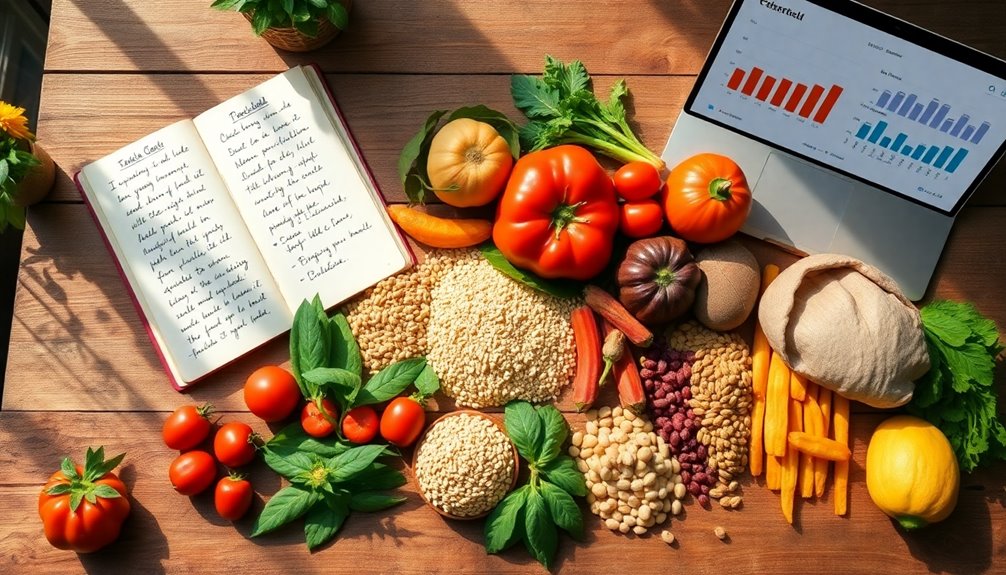
When it comes to emergency food supply guidelines, the expertise of Judy Harrison, Ph.D., and Elizabeth Andress, Ph.D., stands out. As Extension Food Safety Specialists, they focus on emergency preparedness, providing vital insights into how you can effectively manage your food resources during a crisis.
Their extensive research emphasizes the importance of planning for your household's specific needs, guaranteeing you have a well-rounded emergency food supply.
One critical aspect they stress is the necessity of including non-perishable foods in your storage. These foods not only provide essential nutrients but also contribute to your overall food security.
They advise using appropriate food storage containers to maintain freshness and safety, helping you avoid spoilage and waste.
Moreover, Harrison and Andress recommend regularly checking your supplies to verify compliance with nutritional guidelines. This practice not only keeps your food safe but also allows you to adapt your emergency plans as your family's needs change.
Importance of Food Supply
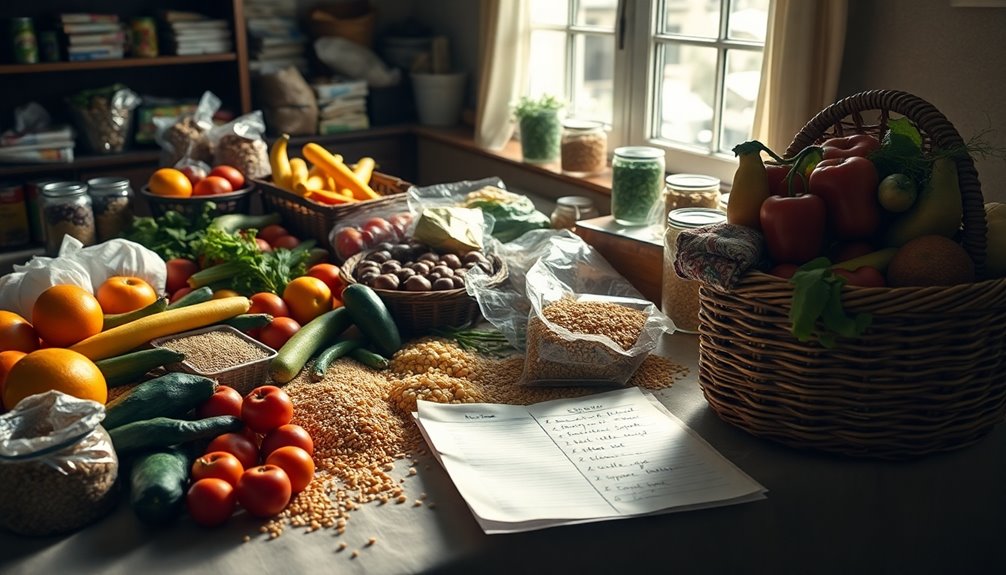
Understanding the importance of a well-planned food supply isn't just about having enough to eat; it's about being prepared for emergencies and maintaining nutritional balance.
You need to reflect on storage and management tips to guarantee your supplies last and stay fresh.
Emergency Preparedness Essentials
A well-stocked food supply is essential for anyone preparing for emergencies. Your emergency food supply should include non-perishable foods, ensuring you have enough nourishment when access to fresh supplies is limited.
Focus on nutrient-dense items like canned meats, fruits, and vegetables, which pack energy without taking up much space. Additionally, consider integrating items like beans and legumes, which are not only nutrient-dense but also provide a good source of protein. When stocking up on supplies, prioritize the highest calorie canned food options, such as chili or stews, which can serve as hearty meal bases. These choices can help ensure you have a satisfying and energizing mix of foods ready for any situation.
To keep your food inventory effective, consider these essentials:
- Water: Aim for at least two quarts per person daily to stay hydrated.
- Food containers: Use airtight containers to keep your supplies fresh and prevent spoilage.
- Expiration date: Regularly check the expiration dates on your items and rotate stock to replace those nearing their end. Additionally, understanding the importance of long-term survival foods can greatly enhance your preparedness strategy.
Nutritional Balance Considerations
Maintaining a well-rounded food supply during emergencies guarantees you meet your nutritional needs, even in challenging situations. A well-planned emergency food supply should include at least one balanced meal daily. Stockpile nutrient-dense non-perishable foods like canned meats, whole grains, and shelf-stable vegetables to keep your energy levels up and overall health intact.
Don't forget the importance of regular hydration. Aim for at least two quarts of water per person each day to support essential bodily functions. Including vitamin and mineral supplements in your emergency food supply can help fill any nutritional gaps, making sure you stay healthy over time.
Diversifying meal options is also vital. Incorporate ready-to-eat cereals, canned fruits, and dried legumes to prevent food fatigue. This variety not only keeps your meals interesting but also guarantees a sustainable food supply throughout an extended emergency.
Storage and Management Tips
Organizing your food supply is essential for managing emergencies effectively. By maintaining an organized inventory, you guarantee easy access during crises and prevent overbuying, which aids in meal planning. Start by designating specific storage areas and clearly labeling your emergency food items. This will streamline access when you need it most.
To enhance your food management strategy, consider these tips:
- Regularly rotate non-perishable foods, consuming older items first to maintain freshness.
- Store items in proper storage conditions, such as keeping canned goods in a cool, dry place and using airtight containers for dry foods.
- Conduct a thorough assessment of your food supplies periodically to identify gaps in your inventory.
Taking these steps won't only maximize shelf life but also improve your overall food security. By marking purchase dates and guaranteeing you consume items before they reach their peak quality, you can enhance food longevity and safety. Additionally, implementing robust security measures in your food storage practices can protect against the risk of spoilage or contamination.
Emergency Food Supply Preparation
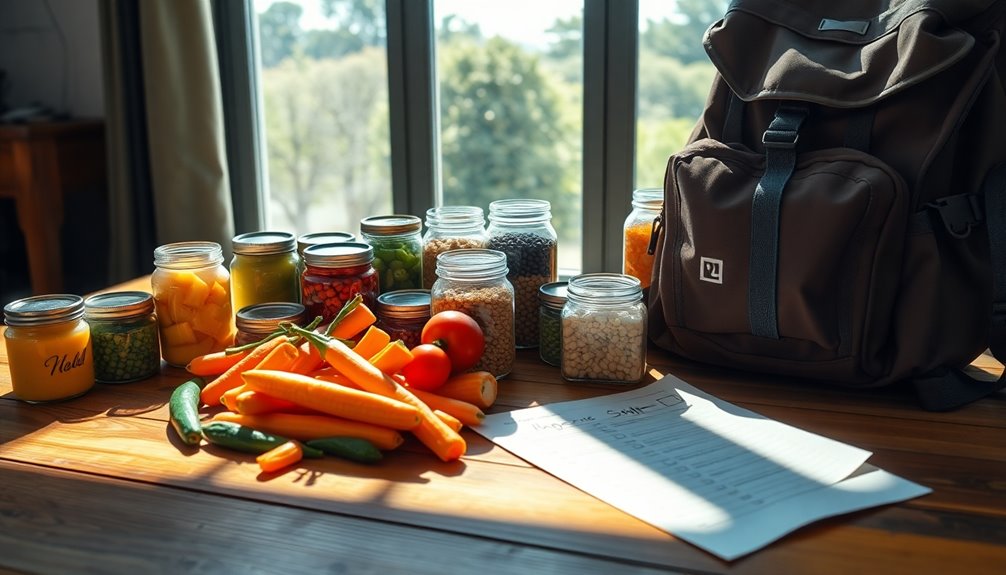
When preparing for emergencies, having a well-stocked food supply can make all the difference during challenging times. Start by gathering enough non-perishable foods to sustain at least one balanced meal daily, along with two quarts of water per person.
Focus on essential items like canned foods—meats, fruits, and vegetables—since they're compact and require no refrigeration. Incorporating freeze-dried foods can add variety to your emergency food options.
Don't forget staples like rice, beans, and ready-to-eat cereals to guarantee nutritious meals. Regularly check and rotate your food supplies, discarding anything expired or unsafe to consume. This practice is vital for maintaining freshness and readiness.
To manage your inventory effectively, maintain a written plan that tracks what you have on hand and what meals you can prepare. This organized approach helps address your nutritional needs and prepares you for unexpected situations.
Long-Term Food Storage Methods
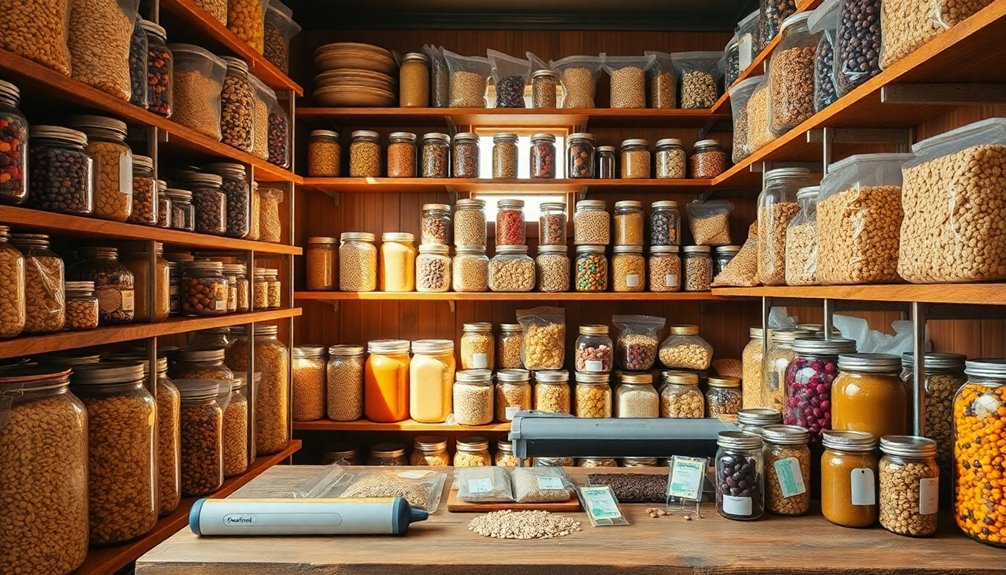
When it comes to long-term food storage, knowing the best practices can make all the difference in keeping your supplies fresh.
You'll want to focus on essential foods like bulk grains and dried dairy options that last for years when stored correctly.
Best Storage Practices
Effective long-term food storage hinges on proper techniques that safeguard your supplies from spoilage and pests. To maintain the best quality of your non-perishable foods, use airtight containers like nitrogen-packed cans or food-grade buckets. This practice extends the storage time considerably, protecting your food from moisture and pests.
Here are some best storage practices to follow:
- Store food in cool, dark, and dry places to preserve the quality of grains and staples for years.
- Regularly rotate your stock, using the oldest items first to guarantee safety and nutrition.
- Label all food items with purchase and expiration dates for easy inventory management.
For dairy, consider dry milk in airtight containers, which can last between 12 to 24 months at 70°F. Alternatives like commercially canned evaporated milk and powdered cheese also offer shelf-stable options.
By adhering to these storage practices, you can guarantee that your food supply remains safe, nutritious, and readily accessible during emergencies.
Essential Long-Term Foods
Building a robust long-term food supply is essential for preparedness and peace of mind. To achieve this, focus on essential long-term foods that can sustain you over time.
Start by stocking non-perishable foods like canned goods, which can last beyond two years if stored in cool, dry locations. Remember to rotate your inventory every 2-4 years to maintain quality and safety.
Consider including dry milk, which can be stored in airtight containers with a shelf life of 12-24 months at 70°F. It's a great dairy option for your long-term supplies.
Additionally, explore commercially packed air-dried or freeze-dried foods for variety and nutrition. These options are lightweight, require minimal preparation, and can easily fit in a well-insulated freezer.
Don't forget about bulk grains like wheat, rye, and rice. Using nitrogen-packed cans or food-grade buckets for long-term storage can preserve their quality for extended periods.
Finally, keep track of your supplies by regularly evaluating and updating your inventory. This practice guarantees you're ready for any situation while preventing spoilage and waste. Moreover, incorporating energy-efficient heat pumps can help maintain optimal storage conditions for your food supplies, ensuring freshness and reducing waste.
Supplementing Bulk Staples
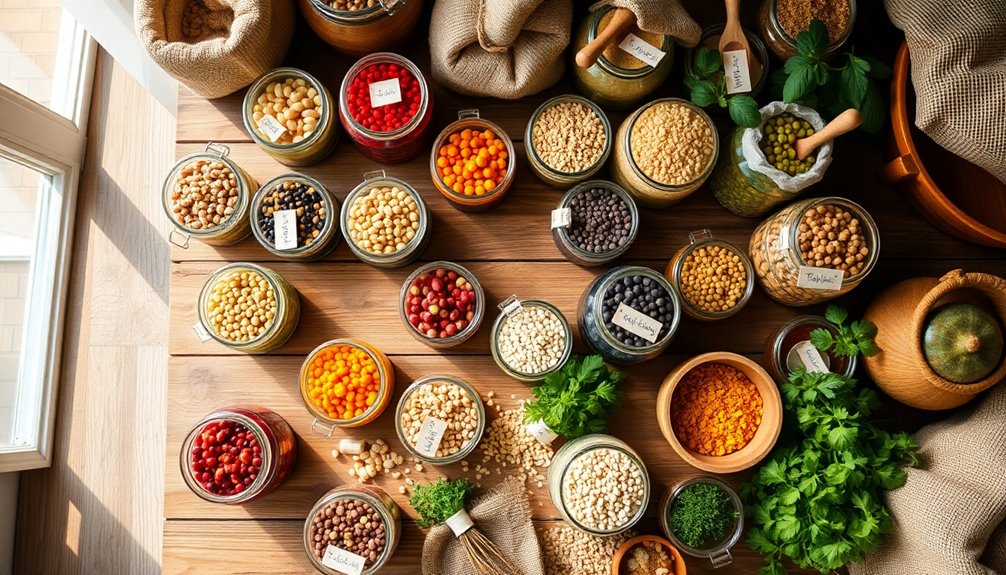
Supplementing your bulk staples can greatly enhance the nutritional value and variety of your emergency food supply. By adding items like canned meats, dried fruits, and ready-to-eat cereals, you'll create a more balanced diet during emergencies. These foods will usually still maintain their quality and flavor even after long storage periods.
Consider incorporating these items:
- Canned foods: Opt for canned meats, vegetables, and baby foods that are nutritious and easy to prepare.
- Dried fruits: These not only provide essential vitamins but also make for a great snack option.
- Convenience mixes: Pasta mixes and ready-to-eat cereals can offer quick meal solutions with minimal cooking time.
When storing these foods, use clean plastic containers to keep them safe from moisture and pests.
Remember, perishable food isn't suitable for long-term storage, so focus on items with a longer shelf life. Additionally, being aware of store hours can help you plan your shopping trips effectively.
Grains and Dairy Storage

When it comes to storing grains and dairy, choosing the right products can make a significant difference in your emergency food supply. High-quality bulk grains like dark hard winter or spring wheat guarantee the best protein and moisture content for maximum shelf life. For dairy products, dry milk stored in airtight containers can last 12-24 months at 70°F, making it a solid long-term option.
Additionally, milled rice offers a longer shelf life than brown rice, providing a nutritious staple. To enhance your storage, consider using nitrogen-packed cans or food-grade buckets for grains, which helps maintain quality over time.
Here's a quick reference table for your grains and dairy storage options:
| Product Type | Storage Method | Shelf Life |
|---|---|---|
| Bulk Wheat | Nitrogen-packed cans or buckets | Long-term, varies |
| Dry Milk | Airtight containers | 12-24 months |
| Milled Rice | Airtight containers | Long-term, varies |
| Canned Evaporated Milk | Canned storage | 1-2 years |
Meal Planning Strategies
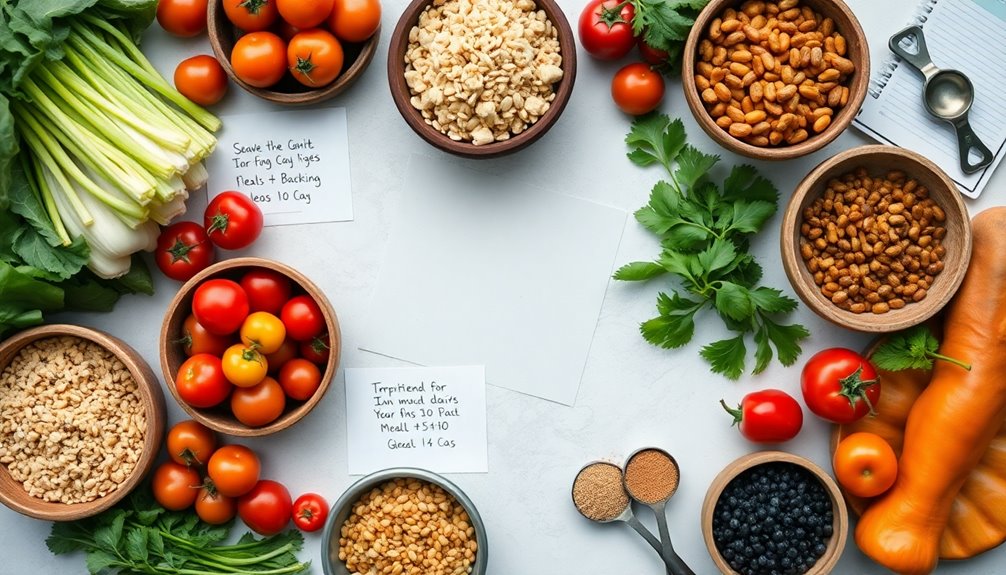
Effective meal planning strategies can greatly enhance your emergency food preparedness. By creating a 30-day meal plan that includes a variety of nutrient-dense foods, you'll guarantee that you're maintaining energy levels and overall health during emergencies.
Incorporate canned and dried foods to diversify your meal choices and prevent food fatigue. To keep your meal plan practical and easy to prepare, focus on high-quality bulk staples such as canned meats, whole grains, and shelf-stable vegetables.
Here are some tips to help you stay organized and efficient:
- Regularly assess your meal plan based on seasonal ingredient availability and personal preferences.
- Track inventory and meal usage to inform future planning, guaranteeing you rotate stock effectively.
- Always check for ice crystals remaining on perishable food to maintain food safety. Additionally, consider utilizing home security systems to protect your food supply from theft or damage during emergencies.
Food Safety and Management
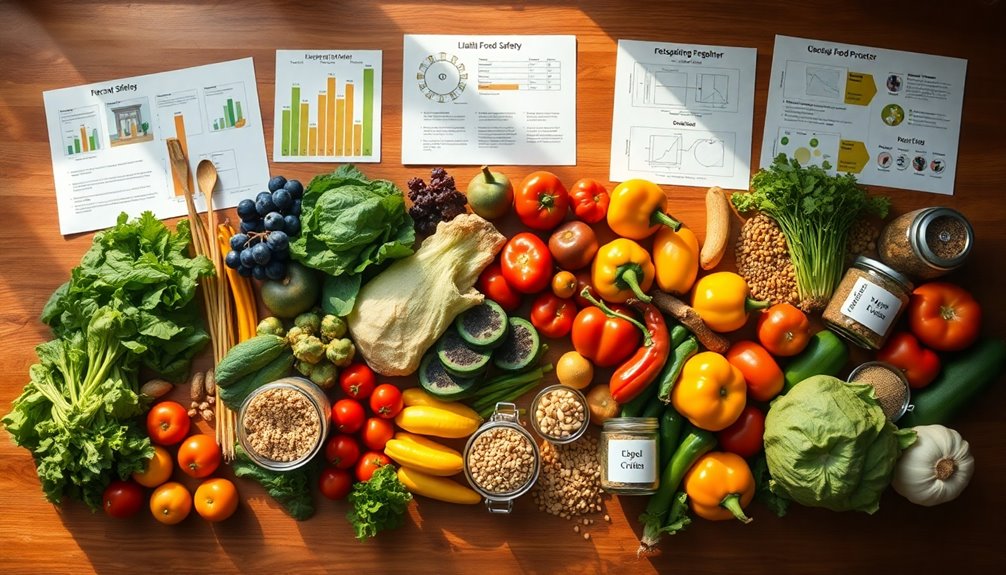
Your food safety and management practices are essential for guaranteeing the longevity and quality of your emergency supplies. Start by organizing your inventory systematically. Regularly date your food items upon purchase and opening. This way, you can easily track freshness and use older items first, minimizing waste.
Canned foods can last beyond two years if stored in proper storage conditions—cool, dry locations away from direct sunlight. Always inspect your cans for damage such as rust or bulging before use.
If you have perishable food, make certain to store it in airtight containers to maintain its safety and quality.
In the event of floods, it's imperative to inspect and sanitize your canned goods before opening them. Discard any home-canned foods or jars that may have been contaminated by floodwaters to avoid health risks. Additionally, regular checks can prevent issues similar to toilet maintenance and repairs that can arise from neglecting proper care.
Adopting these food safety practices not only prolongs the life of your emergency supplies but also guarantees you're prepared for any situation. By maintaining an organized inventory and adhering to these guidelines, you'll enhance both the safety and accessibility of your food storage.
Financial Preparedness and Resources

Financial preparedness plays a crucial role in guaranteeing you can access essential food supplies during emergencies. Keeping cash on hand for emergency supplies allows you the flexibility to make necessary purchases quickly when crises arise.
Regularly evaluating your financial preparedness in relation to your food supply helps you identify areas for improvement, guaranteeing a sustainable approach to food security.
To enhance your financial preparedness and food management, consider these strategies:
- Monitor local food supply and potential shortages through reliable sources.
- Stay updated on grocery store inventories and supply chain alerts.
- Stock up on non-perishable foods to create a buffer during emergencies.
Being proactive in these areas not only saves you money but also enhances your overall food security. Additionally, understanding financial misconduct in alimony decisions can help you make informed choices about your finances, especially if facing a divorce situation.
By reducing reliance on external sources during emergencies, you guarantee that you have adequate emergency supplies at your fingertips.
Remember, informed decisions about your food inventory can help you avoid panic buying and maintain a steady supply of essential items when you need them most.
Embrace financial preparedness today, and you'll be better equipped to face any challenges that may come your way in the future.
Frequently Asked Questions
What Are the Top 10 Foods to Stockpile?
When you're thinking about what to stockpile, consider these top ten foods: canned meats, rice, beans, ready-to-eat cereals, pasta mixes, dried fruits, canned vegetables, powdered milk, peanut butter, and honey.
These items not only have long shelf lives but also provide essential nutrients. Canned meats give you protein, while rice and beans offer versatility.
Diversifying your stock with cereals and dried fruits guarantees you're prepared for any emergency while maintaining a balanced diet.
How Much Food Do I Need for a 1 Year Supply?
To prepare a one-year food supply, you'll need about 400-500 pounds of food.
Focus on essential categories: store 100-150 pounds of grains like rice and oats, 50-75 pounds of legumes for protein, and 30-50 pounds of fats and oils.
Don't forget 40-50 pounds of dehydrated fruits and vegetables to guarantee you get the vitamins and minerals necessary for a balanced diet throughout the year.
What Are the FEMA Food Supply Recommendations?
Think of your disaster supply kit as a lifeboat in a storm; it's essential for survival.
FEMA recommends you keep at least a three-day supply of non-perishable food and water. Stock up on ready-to-eat meals, canned goods, granola bars, and nuts for variety.
Don't forget about dietary needs! Remember to check your supplies regularly, rotating items to guarantee freshness.
Each person should have at least one gallon of water daily for 72 hours.
What Items Should I Stockpile for an Emergency?
You should stockpile a variety of non-perishable foods for emergencies. Canned meats, fruits, vegetables, and high-energy snacks are essential.
Don't forget ready-to-eat meals and vacuum-sealed or freeze-dried options for convenience. Aim to have balanced meals with protein sources like canned beans and carbohydrates like rice or pasta.
Also, include a manual can opener and utensils to prepare meals easily. Rotate your supplies every 2-4 years to keep everything fresh.
Conclusion
By planning your one-year food supply, you're taking a significant step toward food security. Imagine the peace of mind Sarah felt when a sudden storm knocked out power for days. Thanks to her well-prepared food stock, she had enough meals for her family without any panic. You can experience that same comfort by following the strategies outlined in this guide. Start today, and you won't just survive—you'll thrive!

